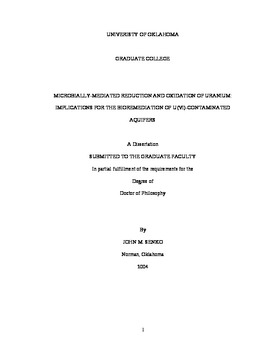| dc.contributor.advisor | Suflita, Joseph M., | en_US |
| dc.contributor.advisor | Krumholz, Lee R., | en_US |
| dc.contributor.author | Senko, John M. | en_US |
| dc.date.accessioned | 2013-08-16T12:19:31Z | |
| dc.date.available | 2013-08-16T12:19:31Z | |
| dc.date.issued | 2004 | en_US |
| dc.identifier.uri | https://hdl.handle.net/11244/784 | |
| dc.description.abstract | Mechanisms of nitrate-dependent U(IV) were assessed by incubating biogenic U(IV) with nitrite or Fe(III). Fe(III) rapidly but incompletely oxidized U(IV) since Fe(II) accumulated during the reaction and inhibited any further U(IV) oxidation. Nitrite alone was a poor oxidant of U(IV), but the addition of a small amount of Fe(II) to nitrite- and U(IV)-containing incubations lead to complete U(IV) oxidation, suggesting that Fe shuttles electrons from U(IV) to nitrite. A nitrate-dependent acetate- and Fe(II)-oxidizing bacterium was isolated from a nitrate- and U(VI)-contaminated aquifer. U(IV) was oxidized by this organism in site groundwater at a greater rate and to a greater extent in the presence of acetate and Fe(II) (where nitrite accumulated to high levels) than under Fe(II)-oxidizing conditions. This activity was due to mineralogical difference in Fe(III) produced under the two conditions. Goethite was produced by enzymatic, nitrate-dependent Fe(II) oxidation and amorphous Fe(III) was produced by the reaction of Fe(II) with nitrite. The latter Fe(III) mineral was a more effective oxidant of U(IV). | en_US |
| dc.description.abstract | We assessed in situ microbial U(VI) reduction. U(VI) immobilization was observed in situ and confirmed as reduction in laboratory sediment incubations. Sulfate neither enhanced nor inhibited U(VI) reduction, but nitrate inhibited U(VI) reduction. U(VI) reduction occurred only after complete consumption of nitrate. The addition of nitrate to U(IV)-containing sediments lead to the oxidation and remobilization of uranium. The addition of intermediates of dissimilatory nitrate reduction (nitrite and nitrous oxide) to heat-inactivated U(IV)-containing sediment slurries lead to the oxidation of U(IV), suggesting that the accumulation of these reactive compounds during dissimilatory nitrate reduction is responsible for nitrate-dependent U(IV) oxidation. Nitrate-dependent U(IV) oxidation may also be catalyzed by Fe(III) that is produced by nitrate-dependent U(IV)-oxidizing bacteria, or by the direct, enzymatic, nitrate-dependent oxidation of U(IV). | en_US |
| dc.description.abstract | Geochemical controls on nitrate-dependent U(IV) oxidation were determined in landfill leachate-impacted sediments. Organotrophic (glucose-oxidizing) and Fe(II)-oxidizing nitrate-reducing bacteria were more abundant in these sediments than organisms that coupled U(IV) oxidation to nitrate reduction for growth, suggesting that U(IV) is ultimately oxidized by Fe(III). In sediment incubations, nitrate concentration exerted a strong influence on the extent, but not the rate of nitrate-dependent U(IV) oxidation. The addition of reductants (acetate, sulfide, soluble Fe(II), and FeS) to sediment incubations lead to lower extents and rates of nitrate-dependent U(IV) oxidation. Fe(II) was the strongest inhibitor of nitrate-dependent U(IV) oxidation. | en_US |
| dc.description.abstract | The effect of Fe(II) form and Fe(II) oxidation rate on Fe(III) mineralogy were determined. Fe(III) from FeS oxidation was amorphous, while Fe(III) from soluble Fe(II) was identified as predominantly goethite. High initial rates of Fe(II) oxidation lead to amorphous Fe(III), and with decreasing rates of Fe(II) oxidation, more crystalline goethite was formed. | en_US |
| dc.format.extent | xix, 152 leaves : | en_US |
| dc.subject | Uranium. | en_US |
| dc.subject | Groundwater Pollution Oklahoma Norman. | en_US |
| dc.subject | Microbial respiration. | en_US |
| dc.subject | Bioremediation Oklahoma Norman. | en_US |
| dc.subject | Environmental Sciences. | en_US |
| dc.subject | Biology, Microbiology. | en_US |
| dc.title | Microbially-mediated reduction and oxidation of uranium: Implications for the bioremediation of uranium(VI)-contaminated aquifers. | en_US |
| dc.type | Thesis | en_US |
| dc.thesis.degree | Ph.D. | en_US |
| dc.thesis.degreeDiscipline | Department of Microbiology and Plant Biology | en_US |
| dc.note | Source: Dissertation Abstracts International, Volume: 65-08, Section: B, page: 3857. | en_US |
| dc.note | Advisers: Lee R. Krumholz; Joseph M. Suflita. | en_US |
| ou.identifier | (UMI)AAI3143544 | en_US |
| ou.group | College of Arts and Sciences::Department of Microbiology and Plant Biology | |
